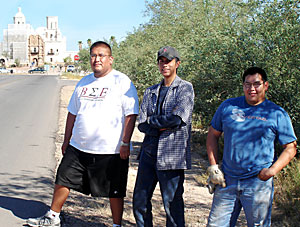 |
|
Photo courtesy of Beta Sigma Epsilon
|
Members of the Beta Sigma Epsilon social fraternity worked to renovate the San Xavier mission last year. The American Indian fraternity is the first of its kind on the West Coast and was started in 2000 to help increase American Indian student retention at the UA.
|
|
|
By Danielle Rideau
Arizona Daily Wildcat
Tuesday, October 18, 2005
Print this
A fraternity that was created with the sole mission of helping American Indians transition from the reservation to the UA has found that while its retention numbers are increasing, there is still room for improvement.
The Beta Sigma Epsilon fraternity was created in 2000 to give American Indian students an opportunity to meet others who were experiencing the same problems transitioning from reservation schools to university life, said Joshua Lucio, a member of the chapter's first pledge class.
Lucio said the transitional problems affect retention because when they don't have a group to relate to, American Indian students may be discouraged from returning after their first year.
Student retention of American Indians is the lowest of all minority groups at the university, with about 64 percent of students returning to the UA for their sophomore year. This number has increased from 60.6 percent from the previous year, said Rick Kroc, the assistant vice president of enrollment research.
Part of the retention problem exists because American Indian students have trouble adjusting to big universities because they experience "culture shock" when transitioning from life on the reservation to a college setting, said Lucio, a microbiology senior.
"Most reservation schools are really small and in small towns," Lucio said. "It can be very overwhelming to go to a school with 35,000 students."
Kroc said this experience, which causes many students to return home, is known as the "external pull."
Students who experience external pull could be first-generation college students or aren't used to taking the full course load of classes, which means they are unprepared for the university, Kroc said.
The fraternity members are trying to create an environment in which American Indian students want to succeed and be a part of a group, which gives them reasons to return to school the following years, Lucio said.
Beta Sigma Epsilon creates opportunities for members to take leadership roles in the fraternity as well as helping other American Indian students in the community, said President Julian Billy.
Because the UA chapter of the fraternity is the founding chapter, members drafted a constitution and bylaws and assist students at other schools who want to open their own chapters, said fraternity Vice President Leroy Walters.
Northern Arizona University is home to the second chapter of the fraternity, and Walters said they have heard interest in opening chapters from students at Arizona State University and the University of New Mexico.
